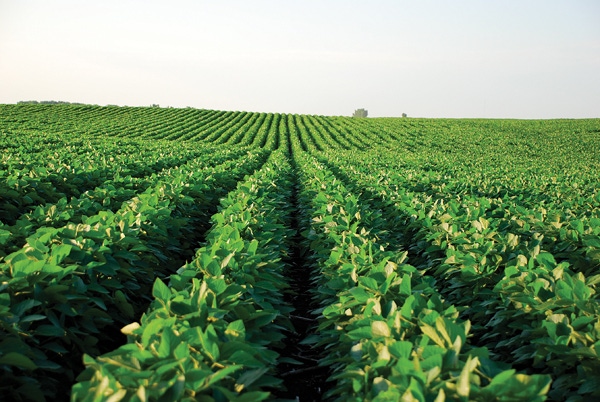December 20, 2013

Pay more attention to soybean varieties to gain as much as 20% in yield, according to Fred Below, professor of crop physiology at the University of Illinois. That’s the spread between the highest- and lowest-yielding varieties grown in the same location in the University of Illinois Variety Testing program.
Below proved this point in an eight-trial study conducted across Illinois to explore the impact of several “high-tech” management practices in soybeans, including seed treatments, foliar fungicides and insecticides, and a fertilizer package including micronutrients. In six of the trials, switching from “normal” to a fuller-season variety boosted yields by 3.2 bushels per acre, confirming the long-held wisdom that fuller-season varieties tend to outperform shorter-season ones.
However, in the other two trials, the fuller-season beans actually delivered lower yields. Below says the longer-season varieties in those two trials turned out to be poorly suited to the sites, illustrating the cost of making the wrong seed choice in intensive management programs.
Shaun Casteel, Purdue University Extension soybean agronomist, points out that top yield figures are just part of the equation.
“High yield is the foundation of variety selection, but high-yield potential doesn’t do you much good if the variety only performs well half the time,” he cautions. “Yield stability is the other part.”
Check variety trial data from several years, if available, and many locations to get a sense of a variety’s yield stability.
Field history is key
Soybean varieties are said to have offensive or defensive traits. Offensive traits are about producing big yields — characteristics like rapid leaf formation, quick leaf expansion, a long-lasting canopy, and the ability to capture or efficiently use water, nutrients and sunlight. Defensive traits are those that confer resistance to key pests and stresses, from nematodes to drought.
The key to choosing among offensive and defensive traits is a thorough understanding of the field’s conditions and history. Among the most important historical notes is the field’s disease history.
“Growers should make sure the variety they select has the right resistance package for their field, because soybean diseases can severely reduce yields,” says Anne Dorrance, Extension soybean expert at Ohio State University.
Other variables can also dramatically influence the success of specific varieties in your field, including:
Tillage system. Soils in no-till fields can be cooler at planting, and may harbor higher levels of pathogens.
Planting date. Soybean yield champion Kip Cullers in Purdy, Mo., points out that he plants taller, more drought-resistant varieties as double-crop beans to make the most of scarce resources between July and harvest.
Soil pH. Acidic soils can tie up calcium, molybdenum and magnesium, according to sources at Asgrow, and increase the risk of herbicide carryover from imidazolinone herbicides. High soil pH can reduce the availability of iron, manganese, boron, copper and zinc, and increase the chances of sulfonylurea herbicide carryover.
Plant characteristics. Where diseases like white mold may be a problem, consider not only resistant genes, but also plants that are shorter and less bushy to reduce the environment that favors the pathogen.
Yes to fertilizer
The next step is making the most of the varieties you choose. “We know variety selection is most important when combined with fertility and row spacing,” notes Below.
Today’s high-powered soybean varieties demand more phosphorus than many people expect. A 70- to 80-bushel-per-acre soybean crop can draw as much phosphorus out of the soil as a 150-bushel corn crop, he explains. Don’t be fooled into thinking that last year’s P application before corn is guaranteed to meet your soybeans’ needs, Below cautions. The huge volume of residue from a hefty corn crop can tie up more than 20 pounds of phosphate and more than 100 pounds of potassium.
The bottom line: Choose good varieties, and give them the nutrients they demand.
Six secrets of soybean success
Variety selection is just one of the six key elements in a top soybean crop, according to University of Illinois researchers Fred Below and Jason Haegele. Their Six Secrets of Soybean Success are:
weather, which can be mitigated by enhanced emergence, strong root development and disease control
fertility, including nitrogen, phosphorus, sulfur and zinc
full-season varieties
foliar protection from insects and fungal pathogens
seed treatment protection, including a fungicide, insecticide and nematicide
20-inch row spacing
Eyes in the sky predict yield
Since the early days of satellite imagery, crop scientists and mathematicians have been studying those pictures with an eye toward getting good data. The images — called the Normalized Difference Vegetative Index, or NDVI — can be used along with complex models to predict crop yields from afar.
Kevin Price, Kansas State University professor of agronomy and geography, was an early adopter of the models. “I used these data to predict yields on eight major row crops in the U.S.,” he says.
Price, who has been gathering this NDVI, or vegetative health index, data since 1989, says he has more than 1,200 images on hand and can build models for every 250-acre area in the continental U.S.
The key is making this information available to farmers in the future, an effort Price is undertaking with a software development project that would allow agronomists to look at trends for any area in the U.S.
Add in the rise of unmanned aerial systems that provide high-resolution farm images, and there’s an additional benefit of the NDVI work. Price says he applied his vegetative health model to cornfield data from an unmanned aerial system and explained more than 92% of the variation in the field’s yield.
You May Also Like




